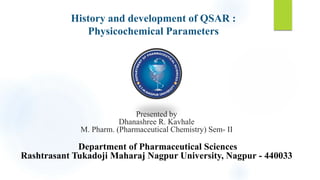
QSAR.pptx
- 1. History and development of QSAR : Physicochemical Parameters Presented by Dhanashree R. Kavhale M. Pharm. (Pharmaceutical Chemistry) Sem- II Department of Pharmaceutical Sciences Rashtrasant Tukadoji Maharaj Nagpur University, Nagpur - 440033
- 2. Contents 1. Introduction 2. SAR v/s QSAR 3. History of QSAR 4. Development of QSAR 5. QSAR and drug design 6. Physicochemical parameters 7. References 2
- 3. What is QSAR….? Measurable molecular properties Some biological activities In form of equation 3
- 4. Continue.. Quantifying the relationship between physicochemical properties and biological activity. mathematical relationship which correlates measurable or calculable molecular properties to some specific biological activity in terms of an equation. so that it can be used to evaluate the activity of new compounds. 4
- 5. Continue.. • QSAR derived equation take the general form: • Biological activity = function(parameters) • Activity is expressed as log(1/c). • Where, c is the minimum concentration required to cause a defined biological response. Purpose of QSAR: To predict biological activity and physic-chemical properties by rational means. To comprehend and rationalize the mechanisms of action within a series of chemicals. 5
- 6. SAR v/s QSAR SAR • Used to develop a new drug that has increased activity. • Mainly done by lead molecule. • It doesn't consider the change in potency. QSAR • Mainly help in drug designing purpose. • Optimize the properties of lead compound. • Deals with the potency and change in efficacy. 6
- 7. History of QSAR • 1900 : H. H. Meyer and C. E. Overton : Lipoid theory of narcosis • 1930 : L. Hammett: Electronic sigma constants • 1964 : C. Hansch and T. Fujita: QSAR • 1984 : P. Andrews: Affinity contributions of functional groups • 1985 : P. Goodford: GRID (hot spots at protein surface) • 1988 : R. Cramer: 3D QSAR • 1992 : H. J. Böhm: LUDI interaction sites, docking, scoring • 1997 : C. Lipinski: Bioavailability rule of five 7
- 8. Development of QSAR QSAR modeling was founded by Corwin Hansch. Tools for modeling of physical and biological properties of chemicals. QSAR models find broad applications for assessing the potential impacts of chemicals, nanomaterials on human health and ecological systems. Achieved by developing QSAR models and employed them for virtual screening followed by experimental validation. 8
- 9. Steps in development of QSAR Data understanding Molecular descriptors Data processing Data cleaning Data transformation Multivariate analysis 9
- 10. Physicochemical Parameters Electronic parameters Electron distribution in the drug molecules affect the drug distribution and activity. Non polar and polar drugs are readily transported through the membrane in unionised form than ionised form. When drug reaches to the target site its electron distribution and structure, controls the type of bond it will form with the target molecules. The bond formations influences the drug biological activity. Two type of electronic parameters are as follows: 1. Hammett equation 2. Dipole movement 10
- 11. Linear Free Energy Relationships Linear Free Energy Relationships allow a correlation of substituents with a reaction rate, biological activity, pKa, etc. To help us understand the magnitude of the sensitivity of parameter to changing substituents, with respect to a reference reaction. What Hammett accomplished : the Hammett equation describes a linear free energy relationship relating reaction rate and equilibrium constant for many reactions involving benzoic acid derivatives. To relate the biological activity of a series of compounds to their physicochemical parameters in a quantitative fashion using a mathematical formula. 11
- 12. Hammett equation It is the measure of substituents ability to donate or withdraw the electron. Determined by using the dissociations of series of benzoic acid substituted derivatives in relation to pure benzoic acid Hammett substitution(𝜎) constant of the particular substituent(x) is defined by using formula. 𝜎𝑥 = log( 𝑘𝑅 𝑘𝐻 ) Where, 𝑘𝑅 = dissociation constant of substituted acid 𝑘𝐻 = dissociation constant of unsubstituted acid 12
- 13. Continue.. 𝜎 value depends upon inductive and resonance effect. And also depends upon whether the substituent is meta or para. Benzoic acid having EWG have larger 𝒌𝑹 value than benzoic acid. So 𝜎 value is positive. Benzoic acid having EDG have smaller 𝒌𝑹 value than benzoic acid. So 𝜎 value is negative. Limitation: It doesn't hold for ortho substituents, this characteristic is known as ortho effect. 13
- 14. QSAR and Drug Design To modify the chemical structure of the lead compound. To retain or to reinforce the desirable pharmacologic effect. Minimizing unwanted pharmacological and physical and chemical properties. To use target analogs as pharmacological probes to gain better insight into the pharmacology of the lead molecule. To reveal new knowledge of basic biology. 14
- 15. References 1. Myint KZ, Xie XQ. Recent advances in fragment-based QSAR and multi- dimensional QSAR methods. Int J Mol Sci. 2010;11(10):3846-3866. Published 2010 Oct 8. doi:10.3390/ijms11103846. 2. Esposito EX, Hopfinger AJ, Madura JD. Methods for applying the quantitative structure-activity relationship paradigm. Methods Mol Biol. 2004;275:131-214. doi:10.1385/1-59259-802-1:131. 3. Verma J, Khedkar VM, Coutinho EC. 3D-QSAR in drug design--a review. Curr Top Med Chem. 2010;10(1):95-115. doi:10.2174/156802610790232260. 15
- 16. Thank you… 16